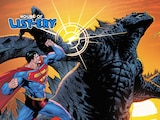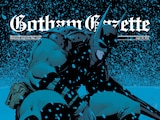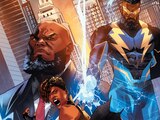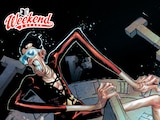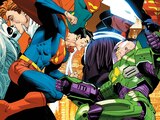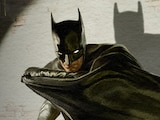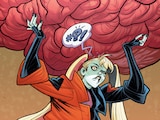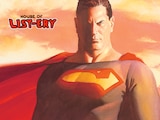Welcome to the first ASK…THE QUESTION of 2023! I’m Alex Jaffe, and if you’re a member of the DC Community, you may already be familiar with my work under the sobriquet of HubCityQuestion. As always, it’s my endeavor to answer whatever questions you may have about the breadth, history and minutiae of the DC Universe, no matter how granular or obscure. If you’d like to submit a question of your own, you can stop by my virtual office at any time to make your inquiries, each of which I will in time address to the best of my ability. Let’s get some answers!
Gentlemen, Let’s Broaden Our Minds

IYQbd asks:
When did the Joker start writing giant HA HA HAs on everything?
The Joker’s laughter as rendered in graffiti has become one of the character’s signature staples, from the movie posters promoting 2008’s The Dark Knight to the adornment of Robin’s costume in Batman v Superman: Dawn of Justice. But when exactly did the Joker begin expressing himself in vandalism?

1946’s Detective Comics #109 is the first time we see the Joker’s HA HA HAs expressed in writing. But it wouldn’t be fair to call that graffiti. In this instance, they’re written on bricks that the Joker is laying to build his own house of jokes. That same year, in Detective Comics #114, the Joker vandalizes signs throughout the city to appear to read “HA HA HA,” but he does this by removing letters or lights in existing signs, rather than spraying it on. It’s close, but not quite the same gag.
1948’s Batman #46 is the first time Joker explicitly defaces a wall with the “HA HA HA,” as part of a longer message. It’s not the big predominant letters we’re accustomed to though, where the laughter is the thrust of the message.

The below cover of 1949’s Detective Comics #149 has absolutely nothing to do with this question. I just wanted you to see it.

Maybe we should back up a little. If not the “HA HA” message specifically, where does the idea of Joker as an artistic vandal come from? Like many of our pop cultural associations with Batman’s main cast, I’d trace it back to an episode of the 1960s Batman television show—specifically “Pop Goes the Joker,” a season two caper where Joker and his gang accidentally start a pop art sensation when they break into an art gallery to deface the paintings. It’s a scene which would inspire the famous art museum heist in 1989’s Batman film, just as the Penguin’s run for mayor in the ’60’s Batman TV show would provide the basis for Batman Returns.
As it turns out, the first instance of the “HA HA HA” graffiti motif we’re familiar with today wasn’t committed by the Joker at all. We see it for the first time in 1999, in the pilot episode of Batman Beyond, an apparent crime by the Jokerz gang of Neo Gotham marking their responsibility for the murder of Terry’s father Warren. In truth, we would learn that Warren’s actual killer was Derek Powers’ enforcer, Mr. Fixx, acting on his employer’s orders. But despite those multiple layers of abstraction, the laughing graffiti has remained a staple of Joker’s repertoire ever since—even defacing the Batcave a year later in Batman Beyond: Return of the Joker. Surely, vandalism will be the charge that keeps him in prison this time.
Prize Fighter

MiscellaneousSoup asks:
How many Pulitzers does Lois Lane have? Has a comic ever shown her accepting one?
As far as we know, Lois Lane has only received one Pulitzer Prize, widely considered the highest recognition in the field of journalism, as established in 1967’s Superman’s Girl Friend, Lois Lane #80. However, we’re never told exactly what story she won the Pulitzer for. To date, the first and only textual source for Lois’s Pulitzer is in the 2006 film Superman Returns.
In the film, Lois won her Pulitzer for an editorial piece entitled “Why the World Doesn’t Need Superman.” The piece was written during Superman’s long absence from Earth implied to have elapsed between the original Christopher Reeve films and the modern Brandon Routh-led follow-up, entreating the people of Metropolis who had come to depend on the Man of Steel to believe in themselves once more.
That’s not to say that no authority on Lois has ever weighed in on this issue. In 2019, New York Times editor and comic book news correspondent George Gene Gustines posed this very question to Greg Rucka and Mike Perkins, the creative team of the contemporary Lois Lane limited series. Rucka and Perkins were of two minds: Rucka believes that Lois won her Pulitzer for a story on Superman’s debut. Perkins, on the other hand, believes that Lois earned her Pulitzer before Superman showed up, establishing her credibility as a reporter even before she became the best-known byline on the Superman beat. Personally, while I have all the love and respect in the world for Rucka, I like Mike’s theory best.
A Poor Synnar’s Hand

jetblackrlsh.82332 asks:
Back in the day it was established that Synnar created the DC Multiverse in Rann-Thanagar Holy War #6. But not too long ago, it was established that Perpetua created the DC Multiverse. One of the big initiatives of Infinite Frontier was to establish that everything happened. So did both Perpetua and Synnar create the DC Multiverse? And if so, how? Are Perpetua and Synnar related in any way, and will we ever get to see these two characters interact in the future?
No connection between Synnar the Demiurge or Perpetua of Scott Snyder’s Justice League has ever been explicitly established in text. In fact, nobody’s even mentioned Synnar, who was originally an enemy of Jemm, Son of Saturn in the 1980s, at all, since the 2008 miniseries by Jim Starlin which brought together some of the more obscure cosmic characters from DC history. Still, there are a number of ways we can explain this discrepancy. In Justice League and its conclusory Dark Nights: Death Metal event, we learn that Perpetua has been expressing her influence in the DC Universe through its greatest villains all this time, from the Anti-Monitor to Darkseid and beyond. One may interpret Synnar’s actions as yet another expression of Perpetua’s will—or even cast Perpetua as the lord Synnar speaks of in Holy War as granting him the power to dream all of creation into existence.
There’s another explanation in a distinction within the consequences of Dark Nights: Death Metal and the subsequent Infinite Frontier, which I fear often goes overlooked. It’s not necessarily that everything which has ever taken place in a DC comic book is now simultaneously, canonically true, but that our principal players have been awoken to the ideas within them. They can remember each version of their complete history, even without it being true to the current expression of reality. So, just because Adam Strange or Hawkman might be able to recall a universe where Synnar was behind its creation does not necessarily mean that he had any role in the creation of the universe as it exists now.
There’s a much simpler explanation than all of this, though, and one I think makes the most sense. When reading this issue of Holy War, you have to consider where the information is coming from. Synnar is a monomaniacal despot who believes himself to be the ultimate power in the universe. Of course HE’S going to tell you that he’s responsible for making all of creation. He might even believe it himself. But Maxie Zeus isn’t the ruler of Mt. Olympus either. As a general rule of advice, I’d say not to believe everything a super-villain tells you.
Our Better Angels

Wrightline1.42741 asks:
My query involves the Spectre and perhaps my understanding (or misunderstanding) of his nature. Whenever God’s creations (the Earth, and all upon it) are threatened with total destruction by forces beyond the abilities of mortal men to deal with, why is the Spectre only occasionally involved? Does he not literally represent God’s presence on our little blue/green marble in space? And if so, should he not act to remove such threats? Or is planetary destruction outside the scope of his “jurisdiction”?
Wrightline, what you’ve hit upon here is the central conflict of most Spectre stories themselves. Police detective Jim Corrigan, chosen after his murder to become an instrument of God as the human host of the Spectre, often wishes he could employ his powers in service of protecting humanity. But the Spectre, for all his divine power, isn’t quite like other superheroes. He doesn’t get a say in which cases he does or does not get to intervene.
In many religions which include the concept of angels, each angel is said to have one specific purpose from which they may not deviate, as that purpose defines their very existence. So too is the case with Aztar, the angel who provides his human host with the power of the Spectre. Like all angels with specified functions, the Spectre is not an instrument of God’s will in total, but specifically an instrument of divine vengeance. The Spectre is not authorized to act to prevent calamity, as that would both be an imposition on free will and outside his job description—he is only able to bring retribution for an injustice already done. And while there have been times where Corrigan has been allowed to pursue cases of his own autonomy, his divine powers in these instances are greatly reduced. Suffice to say that while under the correct circumstances, the Spectre is one of the most powerful beings in the DC Universe, he is at the same time powerless to use those abilities in a way which defies his function.
That presents an interesting philosophical quandary on its own: what sort of god would grant the world a figure of vengeance, but not protection? Does God exist to create and ensure his rules are followed, but without a capacity for mercy? Before you answer that, let me ask you this: how do you think Earth ended up with so many superheroes, all granted powerful abilities through astronomical coincidence, in the first place?
Pronunciation Station

KookieSuperApe asks:
What is the proper pronunciation of Chemo? Key-mo or Khem-mo (or something else)?
As tempting as it is to say “Key-mo” as the word is used in the context of “chemotherapy,” every adaptation of the character to date which uses the name aloud—Batman: The Brave and the Bold, the DC Nation Metal Men shorts, and Batman Unlimited: Mechs vs. Mutants—pronounces it “Khem-mo.”
That’s all the space we have this month, but keep checking in for more answers to all of your burning questions about the cast of thousands which makes up our favorite fictional world. I’ll always be listening, as long as you ASK… THE QUESTION.
Alex Jaffe is the author of our monthly "Ask the Question" column and writes about TV, movies, comics and superhero history for DC.com. Follow him on Twitter at @AlexJaffe and find him in the DC Community as HubCityQuestion.
NOTE: The views and opinions expressed in this column are solely those of Alex Jaffe and do not necessarily reflect those of DC Entertainment or Warner Bros.

